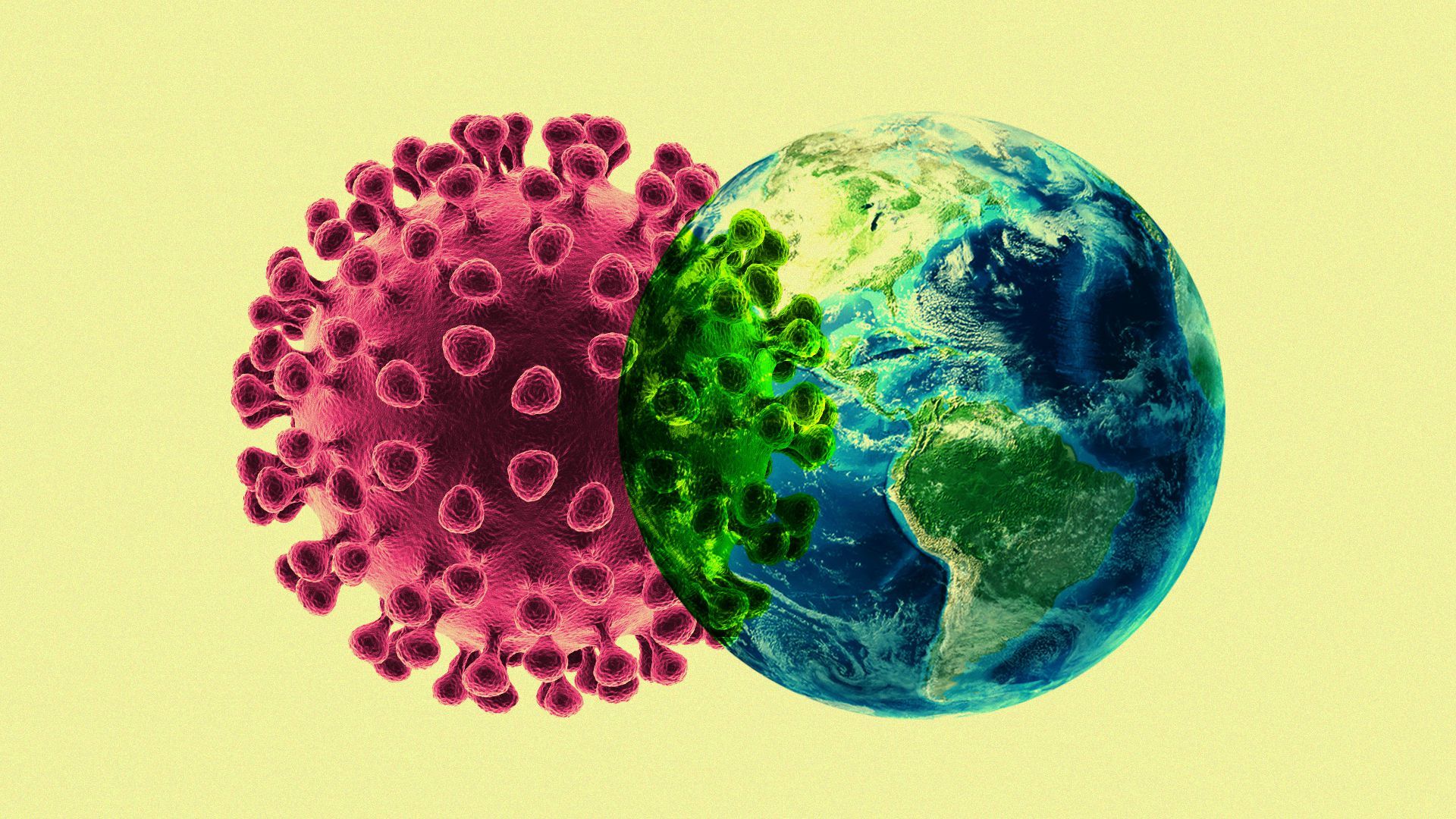Australian wildfires had bigger influence on climate than lockdowns: Study

- Andrew Freedman, author ofAxios Generate

Illustration: Shoshana Gordon/Axios
The COVID-19 pandemic-related lockdowns exerted a slight net warming effect on the planet, but Australian wildfires had a much bigger and faster climate impact, cooling the planet from December 2019 through mid-2020, a new study finds.
Why it matters: The study shows how two largely manmade forces — the response to a pandemic and climate change-related wildfires — can influence the planet, with implications for understanding future climate change.
The big picture: When major economies worldwide began coming to a near economic standstill in January of 2020, emissions of multiple pollutants were reduced, including particulate matter that can reflect incoming solar radiation. So too were planet-warming greenhouse gases.
- The clearing of skies over parts of China was observed by satellites, and similar effects followed COVID-related shutdowns in Italy and other countries in Europe, as well as the U.S.
- With reduced economic activity, greenhouse gas emissions declined by 7% in 2020, but only temporarily.
What they did: In a new study, published in Geophysical Research Letters, scientists used more than 50 different simulations from one of the most reliable climate models available, known as the Community Earth System Model version 2, to simulate the climate response to the COVID-19 pandemic's changes to human activity.
- The model was run multiple times with and without the COVID-related lockdowns included.
- The scientists used the same model techniques, run on a federally-funded supercomputer in southern Wyoming, to analyze another major event that triggered a climate response during a similar timeframe: the Australian bushfires of late 2019 and early 2020.
What they found: The researchers found that the COVID-19-related changes in activity, while jarring for people, exerted only a small influence on the climate through 2022 that can barely be distinguished from natural climate variability.
- And contrary to early assumptions, the lockdowns had a net warming effect on the planet.
- By contrast, the Australian wildfires, which sent vast amounts of particulate matter high into the stratosphere, exerted a "strong and abrupt climate cooling" effect that was so significant it pushed the Intertropical Convergence Zone, where air converges just off the equator to form towering thunderstorms, north of its typical position.
- The fires may even have influenced the behavior of El Niño and La Niña events in the tropical Pacific Ocean, lead author John Fasullo of the National Center for Atmospheric Research told Axios.
The fires, which were part of a climate change-induced worsening trend in wildfires in Australia, were accompanied by mushroom-cloud-like pyrocumulonimbus clouds, or pyroCb clouds. These helped vault smoke to 55,000 feet at times, high enough in the atmosphere to remain there for months at a time.
- The particles contained in the smoke include sulfate aerosols, and they helped modify clouds in ways that enhanced their ability to reflect incoming solar radiation.
- The fires, in other words, acted much like a volcanic eruption, which have a well-known role in cooling the planet for periods of one to three years.
By the numbers: The researchers found the pandemic-related lockdowns will result in an average global warming of about 0.05°C by the end of 2022, whereas the fires cooled the planet in just a few months by about 0.06°C.
- At their peak, the pandemic-related lockdowns increased solar energy at the top of the atmosphere by about 0.23 watts per square meter, using a metric of the balance between heat entering and leaving the Earth's atmosphere.
- In contrast, the Australian fires temporarily cooled the globe by almost a watt per square meter.
What they're saying: "A key mechanism here is that the Australian wildfires and the emissions they produced actually changed the optical properties of clouds across the Southern Ocean, that made clouds more reflective and brighter," Fasullo told Axios.
- As for the COVID-19 lockdowns, Fasullo said the loss of factory and tailpipe emissions as industrial activity slackened, as well people staying in their homes, yielded a net cut in aerosol pollution.
- "That actually warms the climate because you've removed a lot of this cooling pollution from the atmosphere," he said.
- Fasullo said one result from the study is a new appreciation that climate change not only affects wildfire frequency and intensity, but that fires themselves are also a feedback on the climate system.
- "Wildfires represents an influence on the climate system that we have under appreciated," he said, noting that those feedbacks are not included in most of the models used for projecting climate change.